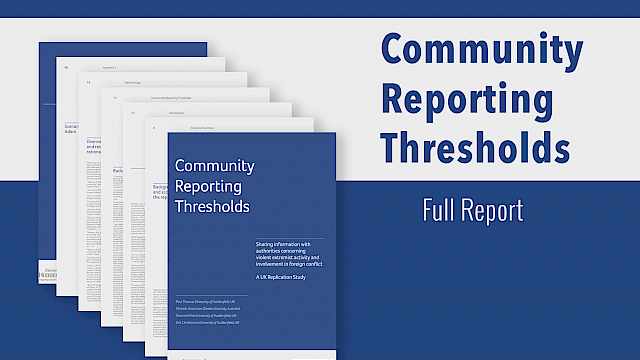Existing research does not indicate that there is a direct causal link between neurodivergence and engagement in criminality or violent extremism in the general population. However, while estimates vary, a proportion of individuals within violent extremist populations are also neurodivergent. Within these individuals, specific symptoms of neurodivergent conditions such as autism spectrum disorder (ASD) and attention-deficit/hyperactivity disorder (ADHD) may contextualise vulnerability to such engagement, as well as resilience and disengagement, that may differ from their neurotypical counterparts.
Practitioners working in counterterrorism contexts have gained valuable insights through working directly with neurodivergent individuals in at-risk populations. This study therefore aims to gather knowledge from practitioners, examining:
- How neurodivergence (particularly ASD) can contextualise violent extremism vulnerability, risk, and resilience;
- Other factors that can increase or decrease risk;
- Approaches and strategies to mitigate risk amongst neurodivergent extremist populations;
- Training needs to support practitioners working with these populations.
These four aims were examined through an analysis of 10 focus groups with a total of 38 practitioners with experience of working with neurodivergent individuals in violent extremism contexts. Most practitioners worked in pre-crime assessment, prevention, and intervention contexts.
Relevant neurodivergent features discussed by practitioners included restricted interests, particularly when terrorism-related; collecting behaviours; sensory needs and sensation seeking; social and communication difficulties; and cognitive rigidity and a need for structure.
The findings suggest that neurodivergent features alone do not directly cause vulnerability or risk to extremism; rather, they can combine with or exacerbate other vulnerabilities, such as those associated with social isolation and rejection; comorbidities and complex needs; difficulties in transitional periods; a lack of support from support systems; and socio-environmental factors such as the impact of the Covid-19 pandemic and the time spent online.
Practitioners emphasised the importance of tailored interventions, particularly those that harness potential protective factors associated with neurodivergence, and neurodivergent-friendly and systems-based approaches. Finally, they recommended improvements for training, highlighting that they would benefit from more in-depth and practical training to guide them through understanding neurodivergent needs in these contexts, as well as appropriate tailored interventions.
Overall, these findings highlight the importance of neurodivergence-informed approaches in practice, bearing important considerations for the management of neurodivergent populations within extremism contexts.
The Full Report of the Practitioner Perspectives on Counterterrorism and Neurodiversity is coming soon. In the meantime, you can download the Executive Summary and Overview on this page.
Read more
Al-Attar, Z. (2018a). Development and Evaluation of Guidance to Aid Risk Assessments of Offenders with Autism. Unpublished MA Dissertation, Sheffield Hallam University.
Al-Attar, Z. (2018b). Interviewing Terrorism Suspects and Offenders with an Autism Spectrum Disorder. The International Journal of Forensic Mental Health, 17(4), 321–337. https://doi.org/10.1080/14999013.2018.1519614
Al-Attar, Z. (2019a). Extremism, radicalisation & mental health: Handbook for practitioners. Radicalisation Awareness Network: Health & Social Care Subgroup, European Commission. https://home-affairs.ec.europa.eu/pages/page/ran-hsc-handbook-extremism-radicalisation-mental-health-handbook-practitioners-november-2019_en
Al-Attar, Z. (2020). Autism spectrum disorders and terrorism: How different features of autism can contextualise vulnerability and resilience. Journal of Forensic Psychiatry and Psychology, 31(6), 926–949. https://doi.org/10.1080/14789949.2020.1812695
Al-Attar, Z. (2021). Framework for the Assessment of Risk & Protection in Offenders with Attention Deficit Hyperactivity Disorder (FARAH). Unpublished Manual.
Al-Attar, Z. (2019b). Introducing the FARAS – a Framework to Aid Risk Assessment with Offenders on the Autistic Spectrum. 18th International Conference on Offenders with an Intellectual and/or Developmental Disability, Birmingham, April 11.
Al-Attar, Z., & Abbasian, C. (2021). ADHD in Adult Prisons: Opportunities for Responsive Rehabilitation, Effective Treatment & Thriving. Unpublished Manuscript.
Al-Attar, Z., & Abbasian, C. (2022). How Do We Talk About Autism & ADHD When Assessing Extremism Risk? Behavioural and Social Sciences in Security, 2022, Lancaster, UK.
Al-Attar, Z., Bates-Gaston, J., Dean, C., & Lloyd, M. (2018). Ethical guidelines for applied psychological practice in the field of extremism, violent extremism and terrorism. The British Psychological Society. https://doi.org/10.53841/bpsrep.2018.inf313
Al-Attar, Z., & Worthington, R. (2023a). Online Terrorism Offenders with ADHD: In what ways can ADHD create contextual vulnerabilities and risk? [Manuscript in Preparation].
Al-Attar, Z., & Worthington, R. (2023b). ADHD and Online Terrorism. Behavioural and Social Sciences in Security, 2023, Bath, UK.
Allely, C. S. (2020). The contributory role of psychopathology and inhibitory control in the case of mass shooter James Holmes. Aggression and Violent Behavior, 51. https://doi.org/10.1016/j.avb.2020.101382
Allely, C. S., & Faccini, L. (2017). A Conceptual Analysis of Individuals with an Autism Spectrum Disorder Engaging in Mass Violence. Journal of Forensic and Crime Studies, 1(1), 1–5. https://doi.org/10.18875/2638-3578.1.105
Allely, C. S., & Faccini, L. (2019). Clinical profile, risk, and critical factors and the application of the “path toward intended violence” model in the case of mass shooter Dylann Roof. Deviant Behavior, 40(6), 672–689. https://doi.org/10.1080/01639625.2018.1437653
Anaele, B. (2020). Risk Factors Related to School Shootings [Master’s thesis, Wilfrid Laurier University]. Wilfrid Laurier University Theses and Dissertations (Comprehensive). https://scholars.wlu.ca/etd/2287/
Antshel, K. M., Zhang-James, Y., Wagner, K. E., Ledesma, A., & Faraone, S. V. (2016). An update on the comorbidity of ADHD and ASD: a focus on clinical management. Expert Review of Neurotherapeutics, 16(3), 279–293. https://doi.org/10.1586/14737175.2016.1146591
Bjørkly, S. (2009). Risk and dynamics of violence in Asperger’s syndrome: A systematic review of the literature. Aggression and Violent Behavior, 14(5), 306–312. https://doi.org/10.1016/j.avb.2009.04.003
Braun, V., & Clarke, V. (2019). Reflecting on reflexive thematic analysis. Qualitative Research in Sport, Exercise and Health, 11(4), 589–597. https://doi.org/10.1080/2159676X.2019.1628806
Bronner, S. J. (2014). ‘The Shooter Has Asperger’s’: Autism, Belief, and ‘Wild Child’ Narratives". Children’s Folklore Review, 36, 35–53.
Broyd, J., Boniface, L., Parsons, D., Murphy, D., & Hafferty, J. D. (2022). Incels, violence and mental disorder: A narrative review with recommendations for best practice in risk assessment and clinical intervention. BJPsych Advances, 1–11. https://doi.org/10.1192/bja.2022.15
Campelo, N., Oppetit, A., Neau, F., Cohen, D., & Bronsard, G. (2018). Who are the European youths willing to engage in radicalisation? A multidisciplinary review of their psychological and social profiles. European Psychiatry, 52, 1–14. https://doi.org/10.1016/j.eurpsy.2018.03.001
Corner, E., & Gill, P. (2014). A False Dichotomy? Mental Illness and Lone-Actor Terrorism. Law and Human Behavior, 39(1), 23–34. https://doi.org/10.1037/lhb0000102
Corner, E., Gill, P., & Mason, O. (2016). Mental Health Disorders and the Terrorist: A Research Note Probing Selection Effects and Disorder Prevalence. Studies in Conflict and Terrorism, 39(6), 560–568. https://doi.org/10.1080/1057610X.2015.1120099
Druitt, F., Smith, D., Spaaij, R., Kernot, D., & Laver, A. (2023). Do autism spectrum disorders (ASD) increase the risk of terrorism engagement? A literature review of the research evidence, theory and interpretation, and a discussion reframing the research-practice debate. Journal of Policing, Intelligence and Counter Terrorism, 18(3), 307–332. https://doi.org/10.1080/18335330.2022.2158361
Eagan, S. H., VosWinkel, F., Ford, J. D., Lyddy, C., Schwartz, H. I., & Spencer, A. (2014). Shooting at Sandy Hook Elementary School. State of Connecticut Office of the Child Advocate. https://portal.ct.gov/-/media/OCA/SandyHook11212014pdf.pdf
Erlandsson, Å., & Meloy, J. R. (2018). The Swedish School Attack in Trollhättan. Journal of Forensic Sciences, 63(6), 1917–1927. https://doi.org/10.1111/1556-4029.13800
Faccini, L. (2010). The man who howled wolf: Diagnostic and treatment considerations for a person with ASD and impersonal repetitive fire, bomb and presidential threats. American Journal of Forensic Psychiatry, 31(4), 47–68.
Faccini, L. (2016). The Application of the Models of Autism, Psychopathology and Deficient Eriksonian Development and the Path of Intended Violence to Understand the Newtown Shooting. Archives of Forensic Psychology, 1(3), 113.
Faccini, L., & Allely, C. S. (2016). Mass violence in individuals with Autism Spectrum Disorder and Narcissistic Personality Disorder: A case analysis of Anders Breivik using the “Path to Intended and Terroristic Violence” model. Aggression and Violent Behavior, 31, 229–236. https://doi.org/10.1016/j.avb.2016.10.002
Faccini, L., & Allely, C. S. (2017). Rare instances of individuals with autism supporting or engaging in terrorism. Journal of Intellectual Disabilities and Offending Behaviour, 8(2), 70–82. https://doi.org/10.1108/JIDOB-11-2016-0022
Gill, P., Clemmow, C., Hetzel, F., Rottweiler, B., Salman, N., Van Der Vegt, I., Marchment, Z., Schumann, S., Zolghadriha, S., Schulten, N., Taylor, H., & Corner, E. (2021). Systematic Review of Mental Health Problems and Violent Extremism. Journal of Forensic Psychiatry and Psychology, 32(1), 51–78. https://doi.org/10.1080/14789949.2020.1820067
Higham, L., Girardi, A., & Edwards, H. V. (2021). Clinical and criminal profile of internet offenders with ASD. Journal of Intellectual Disabilities and Offending Behaviour, 12(2), 61–74. https://doi.org/10.1108/JIDOB-09-2020-0016
HM Inspectorate of Prisons, HM Inspectorate of Probation, & HM Inspectorate of Constabulary and Fire & Rescue Services. (2021). Neurodiversity in the criminal justice system: A review of evidence. https://www.justiceinspectorates.gov.uk/hmicfrs/publications/neurodiversity-in-the-criminal-justice-system/
Home Office. (2023, January 26). Individuals referred to and supported through the Prevent Programme, April 2021 to March 2022. GOV.UK. https://www.gov.uk/government/statistics/individuals-referred-to-and-supported-through-the-prevent-programme-april-2021-to-march-2022/individuals-referred-to-and-supported-through-the-prevent-programme-april-2021-to-march-2022
Kenyon, J., Binder, J. F., & Baker-Beall, C. (2023). Online radicalization: Profile and risk analysis of individuals convicted of extremist offences. Legal and Criminological Psychology, 28(1), 74–90. https://doi.org/10.1111/lcrp.12218
King, C., & Murphy, G. H. (2014). A systematic review of people with autism spectrum disorder and the criminal justice system. Journal of Autism and Developmental Disorders, 44(11), 2717–2733. https://doi.org/10.1007/s10803-014-2046-5
Lloyd, M. (2021). Ethical Guidelines for Working on P/CVE in Mental Health Care. Radicalisation Awareness Network, European Commission. https://home-affairs.ec.europa.eu/networks/radicalisation-awareness-network-ran/publications/ethical-guidelines-working-pcve-mental-health-care-2021_en
Logan, C., & Lloyd, M. (2018). Violent extremism: A comparison of approaches to assessing and managing risk. Legal and Criminological Psychology, 1–21. https://doi.org/10.1111/lcrp.12140
Lösel, F., Bender, D., Jugl, I., & King, S. (2020). Resilience against Political and Religious Extremism, Radicalization, and Related Violence: A Systematic Review of Studies on Protective Factors. In Understanding Recruitment to Organized Crime and Terrorism (pp. 55–84). Springer International Publishing. https://doi.org/10.1007/978-3-030-36639-1_3
Lösel, F., King, S., Bender, D., & Jugl, I. (2018). Protective Factors Against Extremism and Violent Radicalization: A Systematic Review of Research. International Journal of Developmental Sciences, 12(1–2), 89–102. https://doi.org/10.3233/DEV-170241
McLaughlin, T., Blum, K., Steinberg, B., Siwicki, D., Campione, J., Badgaiyan, R. D., Braverman, E. R., Modestino, E. J., Gondre-Lewis, M. C., Baron, D., Mash, D. C., Giordano, J., & Thanos, P. K. (2017). Hypothesizing Las Vegas and Sutherland Springs Mass Shooters Suffer from Reward Deficiency Syndrome: ‘Born Bad’. Journal of Reward Deficiency Syndrome and Addiction Science, 3(2), 28–31. https://doi.org/10.17756/jrdsas.2017-038
Meeks, S. (2020). The Neural Implantation: Cognitive Difference and Contemporary Culture: Vol. Doctor of [Doctoral thesis, Manchester Metropolitan University]. Manchester Metropolitan University’s Research Repository. https://e-space.mmu.ac.uk/626969/
Meloy, J. R., & O’Toole, M. E. (2011). The concept of leakage in threat assessment. Behavioral Sciences and the Law, 29(4), 513–527. https://doi.org/10.1002/bsl.986
Monahan, J. (2012). The individual risk assessment of terrorism. Psychology, Public Policy, and Law, 18(2), 167–205. https://doi.org/10.1037/a0025792
Morrison, J. F., Silke, A., Maiberg, H., Slay, C., & Stewart, R. (2021). A Systematic Review Of Post-2017 Research On Disengagement And Deradicalisation. https://crestresearch.ac.uk/resources/a-systematic-review-of-post-2017-research-on-disengagement-and-deradicalisation/
Salman, N. L., & Al-Attar, Z. (2023). A Systematic Review of Neurodivergence, Vulnerability, and Risk in the Context of Violent Extremism. [Manuscript in Preparation].
Schuurman, B. (2020). Research on Terrorism, 2007–2016: A Review of Data, Methods, and Authorship. Terrorism and Political Violence, 32(5), 1011–1026. https://doi.org/10.1080/09546553.2018.1439023
Shawcross, W. (2023). Independent Review of Prevent. https://www.gov.uk/government/publications/independent-review-of-prevents-report-and-government-response
Silva, J. A., Ferrari, M. M., & Leong, G. B. (2003). Asperger’s disorder and the origins of the Unabomber. American Journal of Forensic Psychiatry, 24(2), 5–44.
Slokan, F., & Ioannou, M. (2021). ‘I’m Not Even Bothered if they Think, is that Autism?’: An Exploratory Study Assessing Autism Training Needs for Prison Officers in the Scottish Prison Service. The Howard Journal of Crime and Justice, 60(4), 546–563. https://doi.org/10.1111/hojo.12432
Tromans, S., Chester, V., Gemegah, E., Roberts, K., Morgan, Z., Yao, G. L., & Brugha, T. (2021). Autism identification across ethnic groups: A narrative review. Advances in Autism, 7(3), 241–255. https://doi.org/10.1108/AIA-03-2020-0017
Van Brunt, B., & Taylor, C. (2020). Understanding and Treating Incels: Case Studies, Guidance, and Treatment of Violence Risk in the Involuntary Celibate Community. Routledge. https://doi.org/10.4324/9780367824396
Wachtel, L. E., & Shorter, E. (2013). Autism plus psychosis: A ‘one-two punch’ risk for tragic violence? Medical Hypotheses, 81(3), 404–409. https://doi.org/10.1016/j.mehy.2013.05.032
Weenink, A. W. (2015). Behavioral Problems and Disorders among Radicals in Police Files. Perspectives on Terrorism, 9(2), 17–33.
White, S. G., Meloy, J. R., Mohandie, K., & Kienlen, K. (2017). Autism spectrum disorder and violence: Threat assessment issues. Journal of Threat Assessment and Management, 4(3), 144–163. https://doi.org/10.1037/tam0000089
Woodbury-Smith, M. R., Loftin, R., Westphal, A., & Volkmar, F. R. (2022). Vulnerability to Ideologically-Motivated Violence Among Individuals With Autism Spectrum Disorder. Frontiers in Psychiatry, 13, 1–6. https://doi.org/10.3389/fpsyt.2022.873121
World Health Organisation. (2019). 6A02 Autism spectrum disorder. In International statistical classification of diseases and related health problems (ICD) (11th ed.). http://id.who.int/icd/entity/437815624
Worthington, R., Al-Attar, Z., Lewis, A., & Pyszora, N. (2021). Rapid Evidence Assessment (REA) on Neurodiversity and Violent Extremism. AVERT. https://www.avert.net.au/s/Rapid-Evidence-Assessment-on-Neurodiversity-and-Violent-Extremism.pdf
Copyright Information
As part of CREST’s commitment to open access research, this text is available under a Creative Commons BY-NC-SA 4.0 licence. Please refer to our Copyright page for full details.
IMAGE CREDITS: Copyright ©2024 R. Stevens / CREST (CC BY-SA 4.0)






